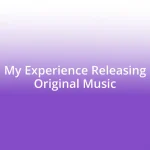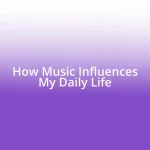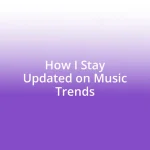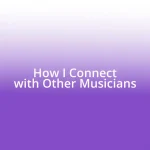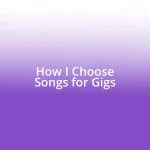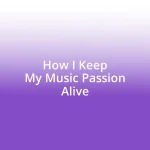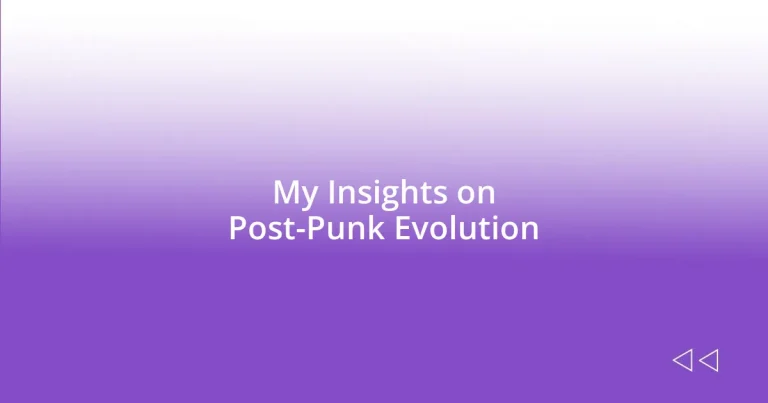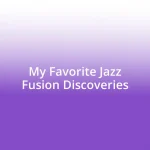Key takeaways:
- Post-punk emerged in the late 1970s as a reaction to traditional punk, blending various genres and fostering experimentation in sound and themes.
- Key artists like Joy Division, Siouxsie and the Banshees, The Cure, and Gang of Four shaped the genre with their unique contributions, influencing countless musicians and cultural narratives.
- The genre’s influence extended beyond music into fashion, art, and broader societal attitudes, promoting introspection and challenging societal norms.
- Modern post-punk sees a resurgence with bands like Interpol and Shame, incorporating contemporary themes and diverse sounds while maintaining the genre’s spirit of authenticity and rebellion.
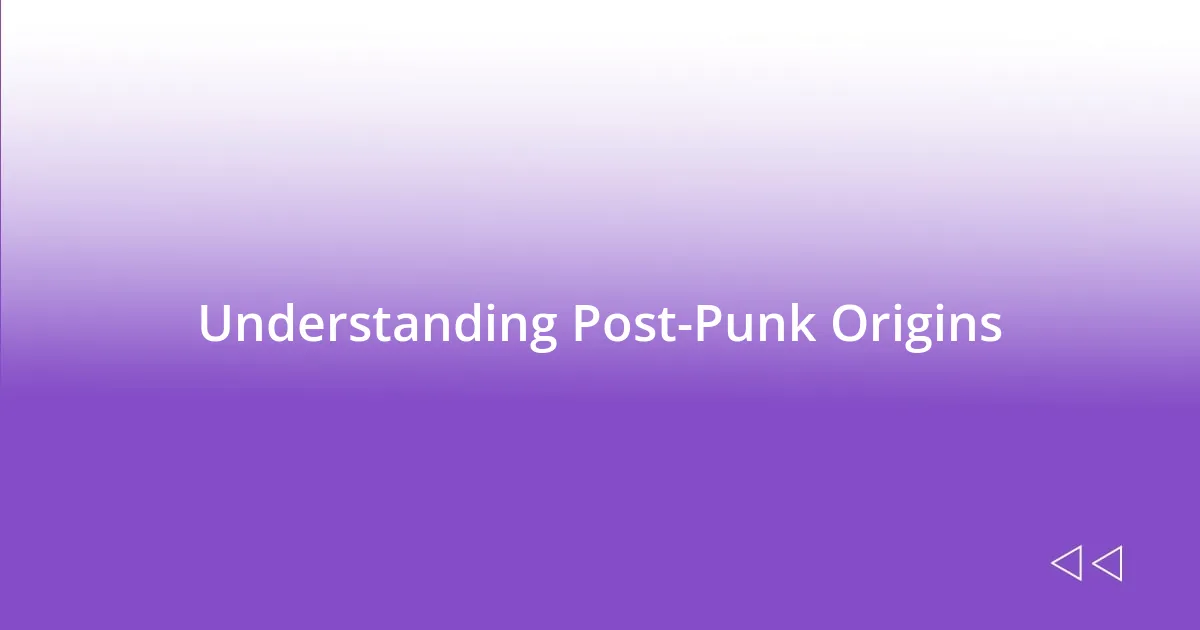
Understanding Post-Punk Origins
The origins of post-punk can be traced back to the late 1970s, a period marked by the decline of traditional punk rock. I remember flipping through vinyl records at a local store and stumbling upon bands like Joy Division and Siouxsie and the Banshees. It felt like discovering a hidden language, one that spoke to the disillusionment and existential angst many of us were experiencing at the time.
As punk’s raw energy began to blend with other genres, artists started to experiment with mood, texture, and unconventional sounds. It makes me think: how often do we find ourselves embracing new forms of art when the old ones no longer resonate? This evolution fostered an atmosphere where innovation thrived, giving birth to a sound that was both haunting and richly layered.
I’ve often reflected on how post-punk was as much about the ideology as it was about the music. See, there was a sense of liberation in exploring darker themes and avant-garde aesthetics, much like peeling back the layers of our psyche. The genre became a canvas for artists to express their struggles, thoughts, and the chaos of a rapidly changing world, forging a connection with listeners who felt just as lost.
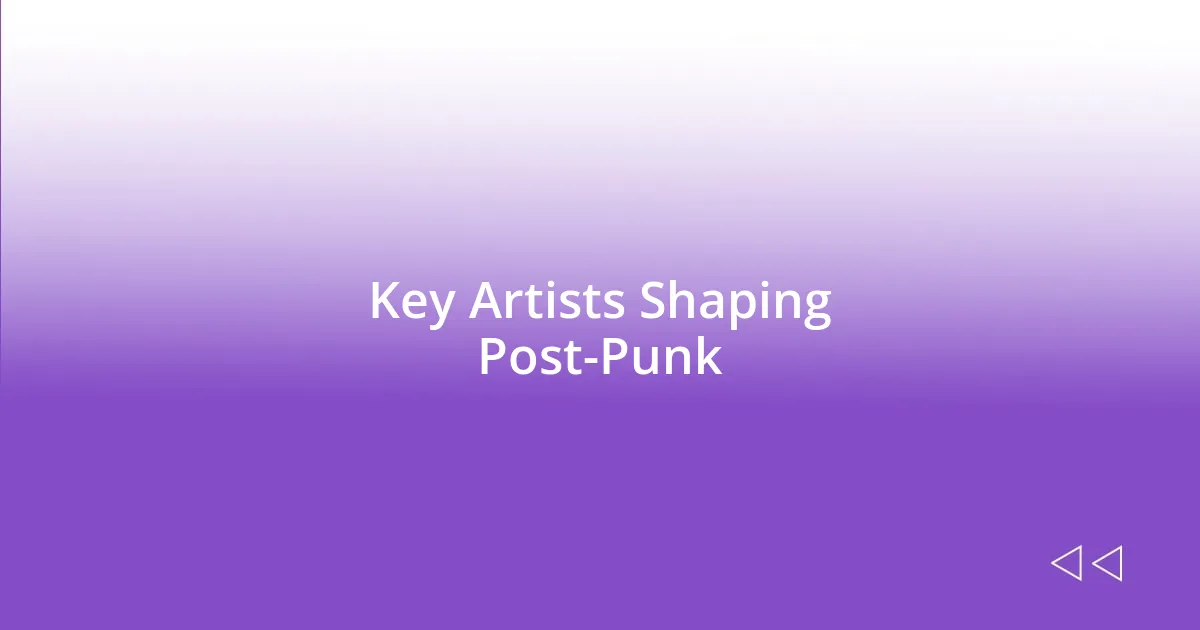
Key Artists Shaping Post-Punk
The impact of key artists in post-punk cannot be overstated. For instance, Joy Division, with their haunting melodies and introspective lyrics, captured a sense of melancholy that resonated deeply with many of us. I remember listening to “Atmosphere” late at night; the song felt like a companion during my own moments of uncertainty, echoing feelings I struggled to articulate.
Siouxsie and the Banshees also paved new paths within the genre, infusing elements of glam rock and gothic tones that were both captivating and rebellious. Their track “Hong Kong Garden” was one of those discoveries that transformed my perspective on music. It was thrilling to hear a female voice so boldly address complexity and depth in a way I hadn’t encountered before.
Furthermore, bands like The Cure and Gang of Four further expanded the sonic boundaries of post-punk. It’s fascinating to see how their distinctive styles influenced countless artists that followed. Listening to “Love Will Tear Us Apart” or “Damaged Goods” still evokes a mix of nostalgia and inspiration in me. These artists shaped not only the sound but also the ethos of a generation grappling with identity and change.
| Artist | Key Contribution |
|---|---|
| Joy Division | Haunting melodies that captured existential angst |
| Siouxsie and the Banshees | Eclectic mixture of glam rock and gothic elements |
| The Cure | Melodic soundscapes that influenced alternative rock |
| Gang of Four | Incorporation of post-punk and politics in music |
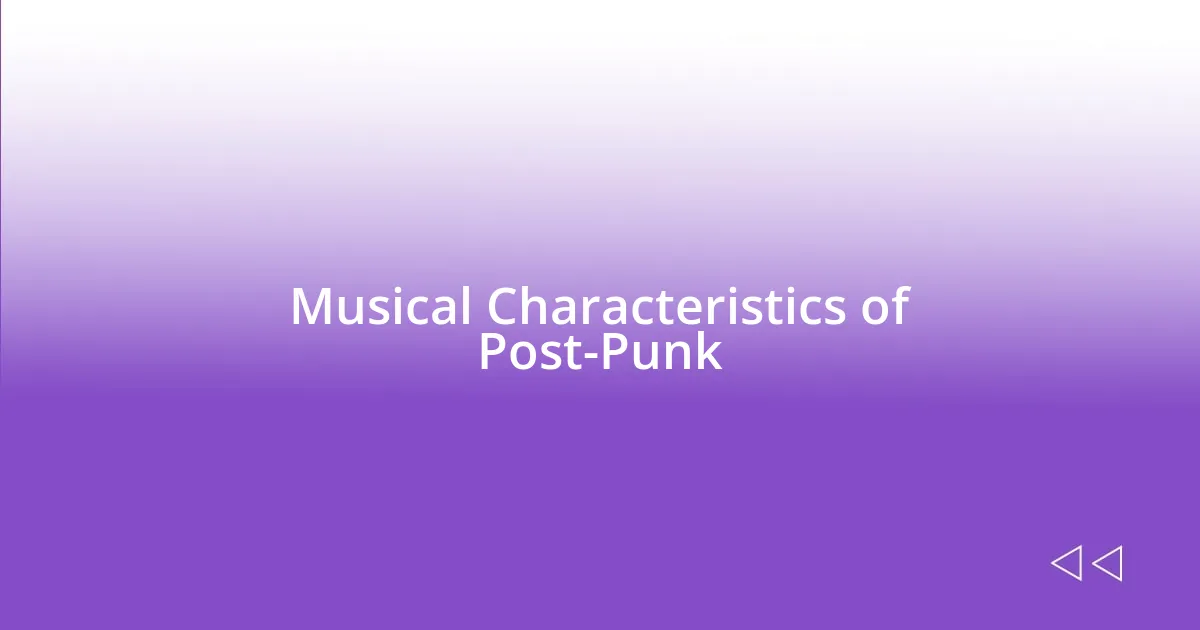
Musical Characteristics of Post-Punk
Post-punk’s musical characteristics are as diverse as the artists who shaped its sound, marked by a rich tapestry of influences and innovative approaches. When I first heard the angular guitar riffs and minimalist bass lines that defined the genre, it ignited a sense of curiosity within me. There was something irresistibly compelling about the way post-punk artists blended rhythms and unconventional song structures, taking risks that pure punk often avoided. The atmospheric quality of the music gave it a haunting beauty, inviting listeners like me to dig deeper into the themes presented.
Here are some key characteristics that stand out to me:
- Dissonant Structures: Unlike traditional punk, post-punk embraced dissonance and unconventional tunings, creating a sense of unease.
- Polyrhythmic Patterns: I recall feeling totally entranced by the layered drum work, which often combined multiple rhythms to create a complex sonic landscape.
- Experimental Sounds: Artists experimented with synthesizers and tape loops, pushing the sonic boundaries to craft unique textures.
- Introspective Lyrics: The lyrical content often delved into emotional and political themes, reflecting a sense of disillusionment that resonated with listeners.
- Vocal Styles: Diverse vocal techniques emerged—ranging from haunting whispers to powerful shouts—that added depth and authenticity to the music.
These musical elements merged to create something truly unique. Listening to bands like Wire or the Banshees, I often felt like I was experiencing the sound of a generation grappling with existential questions and societal changes. This was a space where creativity met raw emotion, which still captivates my heart to this day.
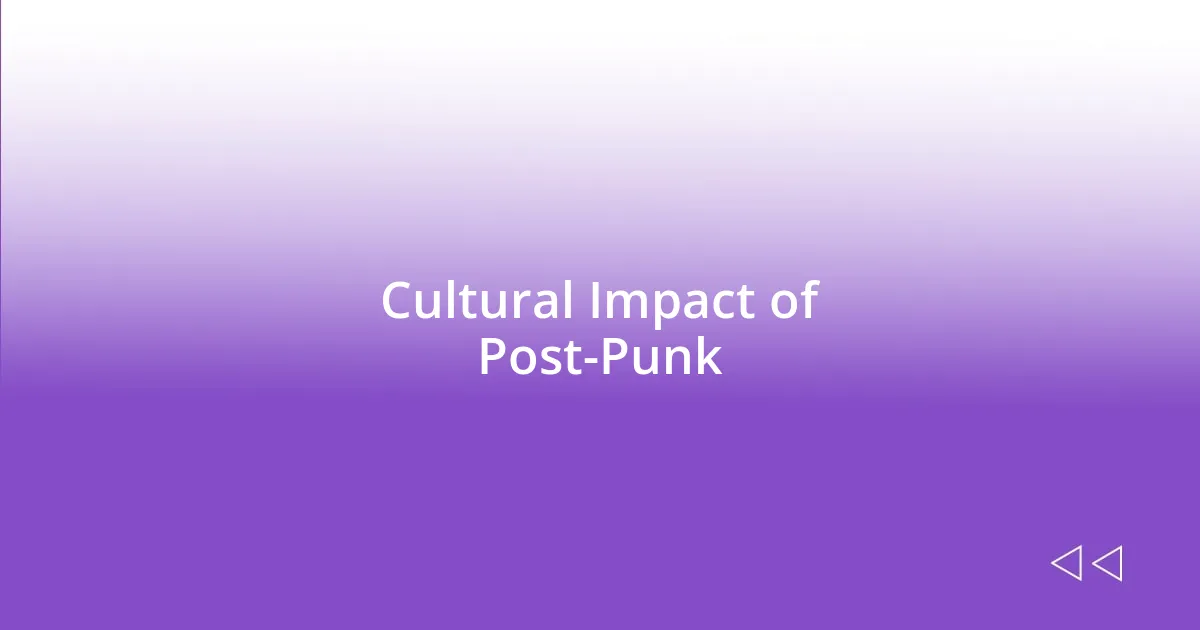
Cultural Impact of Post-Punk
The cultural impact of post-punk extends beyond music, influencing fashion, art, and even social attitudes. I still remember the first time I stepped into a club with walls adorned in bold artwork inspired by post-punk aesthetics. It felt like entering a vibrant movement where everyone expressed themselves differently, celebrating an individuality that resonated deeply. The visual style, characterized by edgy designs and a mix of styles, encouraged people to push against societal norms.
One of the most profound effects post-punk had was its embrace of introspection and vulnerability. I often find myself reflecting on how songs like “Bela Lugosi’s Dead” sparked conversations about deeper emotions and societal issues. For many, it was a relief to hear these artists vocalize feelings of isolation or confusion that previously went unaddressed. Wasn’t it liberating to know we weren’t alone in experiencing life’s complexities?
As post-punk went global, its themes influenced not just musicians but also writers and filmmakers. I recall watching films from that era, like Repo Man, that echoed post-punk’s rebellious spirit and anti-establishment sentiment. It made me realize how integral the music was to a larger cultural narrative, one that challenged conventions and encouraged self-exploration. That fusion of music and art really sparked a renaissance of creativity, didn’t it? It was a time when culture was not just consumed but actively participated in, paving the way for a new generation of artists to express their truths boldly.
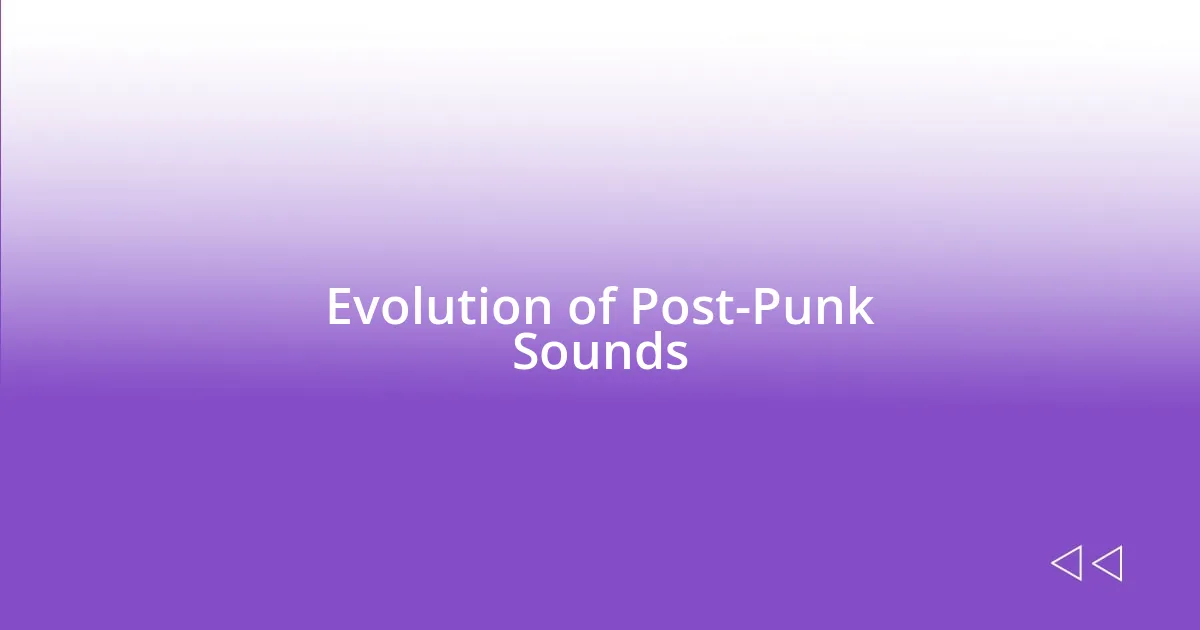
Evolution of Post-Punk Sounds
While examining the evolution of post-punk sounds, I can’t help but think about the early experimentation that defined its formation. Bands pushed the envelope, often blending punk energy with an array of sounds—from dub to electronic influences. I vividly recall discovering tracks that seamlessly transitioned from driving guitar riffs to ethereal synth melodies, which felt like embarking on an unpredictable sonic adventure. Doesn’t that excitement of not knowing what’s coming next add an extra layer of fascination?
As the genre matured, I saw it embrace an even broader palette of instruments and techniques. Incorporating technologies like drum machines and sequencers allowed artists to explore new textures previously unheard in music. I remember the first time I listened to Joy Division’s “Love Will Tear Us Apart”—the icy precision of the drum machine mixed with haunting lyrics struck a chord deep within me. How incredible is it that artists can evoke such raw emotions through innovative soundscapes?
Eventually, international acts began interpreting post-punk through their cultural lenses, infusing local genres and sensibilities. For instance, the Brazilian band Os Mutantes sparked my interest with their unique fusion of psychedelic rock and post-punk elements. Their vibrant sounds encapsulated a feeling that was both familiar and entirely new. Isn’t it thrilling to see how music can transform and adapt, creating a rich tapestry of global influences while staying true to its roots? This evolution not only reflects the genre’s dynamic nature but also ensures its enduring relevance across generations.
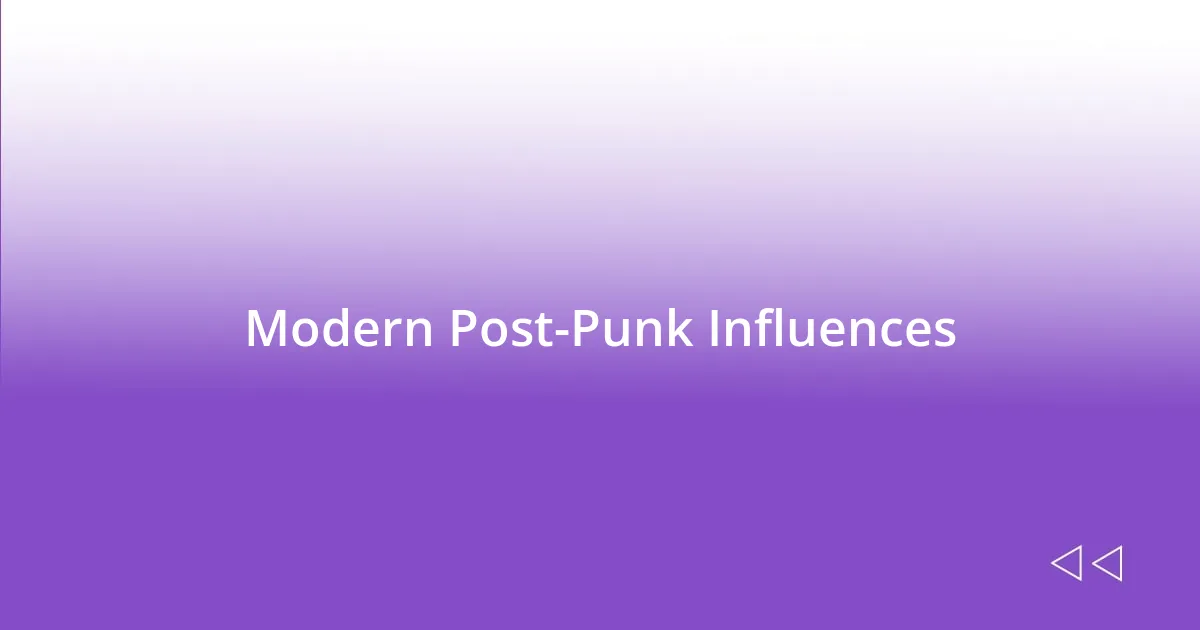
Modern Post-Punk Influences
Modern post-punk is experiencing a renaissance, with contemporary bands drawing inspiration from the genre while infusing their own unique identities. When I stumbled upon the group Interpol, I was taken aback by their ability to weave atmospheric sounds reminiscent of the early post-punk era into a fresh narrative. Isn’t it fascinating how they manage to evoke a sense of nostalgia while simultaneously pushing the boundaries of what post-punk can mean today?
Moreover, I’ve noticed how the genre’s themes have seeped into the realms of technology and digital culture. Bands like The XX blend minimalist soundscapes with personal, introspective lyrics, creating a dialogue that resonates with the ticketed lives we lead in today’s fast-paced world. It reminds me of late-night drives where the music blends perfectly with thoughts swirling in my mind—how does music so accurately capture our modern anxieties?
I’ve also been particularly struck by the resurgence of the DIY ethic in modern post-punk. Acts like Sleaford Mods infuse their lyrics with biting social commentary, using a no-frills approach that feels provocatively authentic. It takes me back to the heart of what post-punk stood for in its early days: breaking barriers and speaking truth to power. It’s invigorating to see this spirit live on, encouraging a new generation to harness their voice and challenge the status quo. Doesn’t it feel like a call to arms in our current cultural landscape?
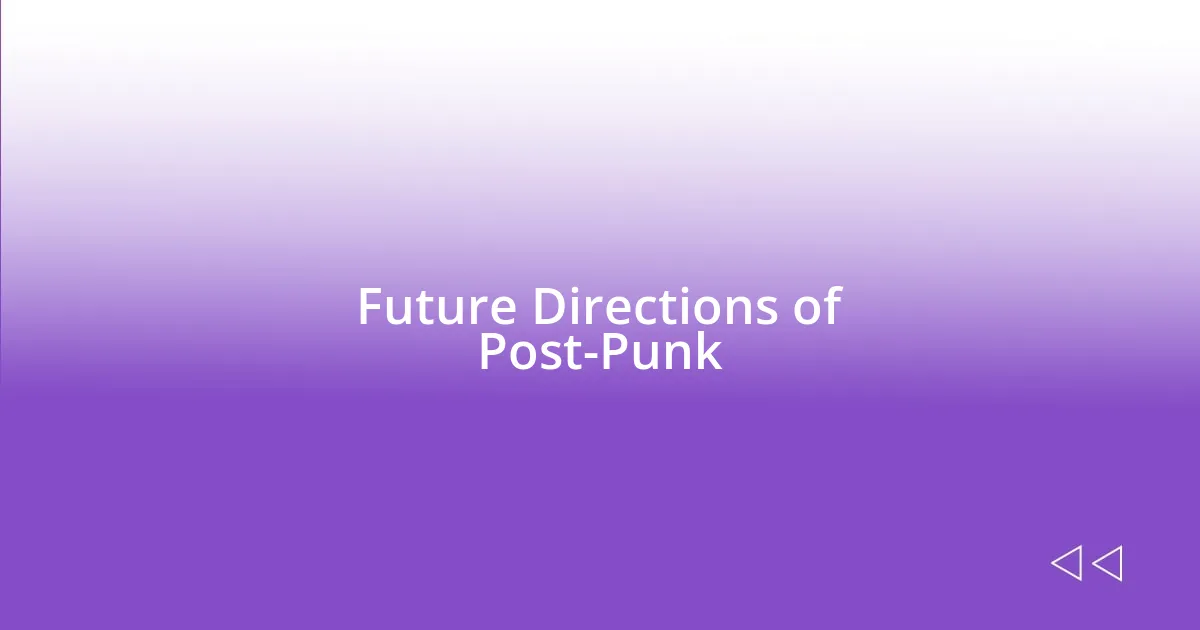
Future Directions of Post-Punk
The future of post-punk excites me as I see bands straddling the line between tradition and innovation. When I hear newer acts like Fontaines D.C. mixing traditional post-punk riffs with punk poetry, I can’t help but think about my own teenage angst—it’s like they’re channeling that raw energy from the past while also reflecting modern struggles. Isn’t it amazing how music can serve as both a time capsule and a mirror for today’s issues?
There’s a palpable shift as artists experiment with more diverse sounds and genres. I’ve been particularly inspired by how artists like Shame incorporate elements of hip-hop and funk, creating a dynamic sound that feels both vibrant and relevant. It evokes memories of my own explorations in music where mixing genres broadened my appreciation. How does it happen that newer inspirations can breathe life into something that once felt fixed?
Additionally, the rise of digital platforms is democratizing music creation, allowing independent artists to flourish. I’ve encountered so many raw, authentic voices online, like PVA, whose invigorating beats remind me of the thrill I felt while discovering underground music in my youth. This makes me wonder: could the next big post-punk movement arise from unexpected corners of the internet, continuing the genre’s legacy of innovation and rebellion? The possibilities seem endless, and I can’t wait to hear what’s next.




